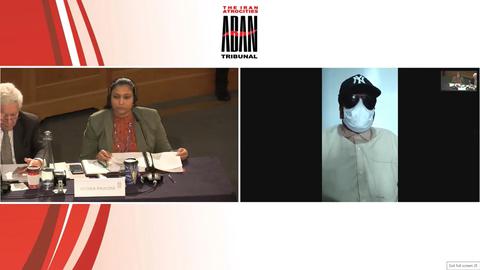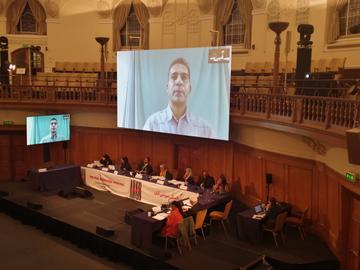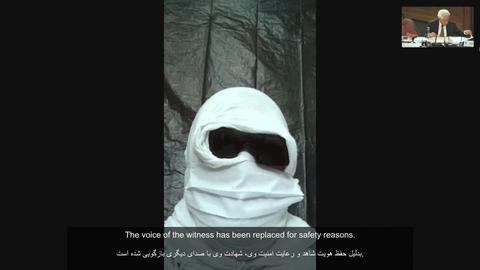On the third day of the Aban Tribunal, those present heard harrowing testimonies not just about the scale of the slaughter in November 2019 but the lengths officials went to trying to cover it up. Between 1,500 and 3,000 people are thought to have been killed in the state crackdown on Iran’s November 2019. Thousands more suffered serious, sometimes life-altering injuries. Several witnesses who spoke on Friday affirmed that security forces had given vulnerable Iranians no peace even after committing atrocities.
“They Called and Said ‘We’re Observing You’”
A devastated family was shadowed by Iranian security forces all the way to their child’s burial place, the tribunal was told. The young man in question, a 37-year-old laborer and father of three, was trying to get home from work on November 15 when he was fatally shot in the very first hours of the protests.
It took his relatives two to three days to track him down. They then faced a long wait to retrieve his body while the authorities investigated them. The victim’s elder brother, named as Witness 31, told the court: “They asked, ‘Is there a thug in this family? Is there riffraff in this family? Unfortunately they couldn’t find anything to say that we were bad people. So they contacted us themselves, and said ‘Go to the provincial capital to take delivery of the body.’ When we got there, they said ‘We’ve taken care of everything.’”
A pathologist later told the family he had been shot in the skull at close range with a military firearm, while he was stood about 25m from a gas station.
As the family were preparing for the funeral, Witness 31 said, “At 2am they called us and said ‘Right now, tonight, you have to come and bury it right now.’ We asked why. Why, during the night? This wasn’t a lone person with no relatives; why did he have to be buried like an unknown?”.
At 5am, the family collected the body and made their way by car to Tehran’s Behesht-e Zahra Cemetery. It was raining. “They were supervising us [lest] we make a move they didn’t like,” Witness 31 said. “They called and said, ‘Beware not to say this or that, because we’re observing you.’ I myself was driving the ambulance. The weather wasn’t good, and the region we were passing through was very difficult to drive in. They questioned, ‘Why are you driving so slowly?’. I told them: ‘One person killed is enough.’”
When they reached the cemetery, the family were told to bury their loved one before 8am, or they would have to wait until the next night. When they asked why, anguished that their relatives could not join them, they were told: “This is about the security of the city. If you take the body into the streets there might be another uprising.” Witness 31 said the cemetery itself was swarming with armed guards, with snipers posted on the roof overseeing mourners. They managed a dignified burial only “to a certain extent”.
“My brother was a simple worker returning to his house,” the witness told the Aban Tribunal. “Even if somebody took a step wrong, you have no right to shoot that person in the head and kill them. They promised us they would find the perpetrator and make him pay.” A military court later indicated to the family the killer had been a member of the police’s NAJA special forces, on a motorcycle. It would, they were told, be “taken care of”.
The man’s wife and three children were granted 300 million tomans (about $10,500) in “blood money”: about the price of two cars, and roughly what he would have earned in six months to a year. They were also granted 1.5m tomans a month in social security payments: about 50 dollars. Asked by the panel if he believed this woefully insufficient sum to be a tacit admission of guilt, Witness 33 answered: “Yes. This was an admission by the authorities that they had killed him.”
“Security Agents Came to the Hospital. This is Not Normal”
Security agents and staff from the governor’s office combed a hospital to check on the status of a critically injured detainee, a medical student testified. Witness 109 was working two shifts a week after the November 2019 protests, and described one particular patient admitted to the ICU after being shot in the head.
“They hadn’t transferred him to the hospital [by ambulance] the day before, and he got here with great difficulty,” the witness said. “The security forces wouldn’t allow anybody to ride in the ambulance. He underwent surgery; one quarter of his brain had been destroyed. The bullet had entered the skull; it had entered the back of his head and come out of the brow.” Colleagues with more experience likened the bullet to that used in a Kalashnikov or Dragunov.
In an unprecedented move, members of the security forces came to the hospital to ask about the injured man’s condition. Asked if this was normal, Witness 109 said: “No, it is not normal. Under normal circumstances, it never happens.” Then on November 26, four officials from the provincial governor’s office entered the ICU, asking where the man had been shot. “The ICU [door] has a code,” the witness said. “Not everybody can enter.”
The young physician said he had heard the same officials had come by looking for other patients. “At other hospitals, they were even blocking the doors and not allowing doctors to admit people.”
State TV Reporter Came to Pressure Bereaved Family
Kamyar Ahmadi broke down in the courtroom as pictures of his nephew flashed up on the screen. The political activist had come from Norway to London to tell the court about the horrendous fate of his 28-year-old nephew, Ershad Rahmanian.
Ershad, a paramedic living in Marivan, Kurdistan province, was going to the bank when he was arrested a week after the protests began. Four days later, his bloodied body was discovered floating near the Garan dam. Ershad’s mother passed out, and his father, a former Ministry of Education official, suffered a heart attack on seeing him there.
“Ershad had finished his BA, and he was getting ready to get an MA,” Ahmadi told the court as graphic photos of Ershad’s body were shown. “He was a vegetarian. He loved nature. He loved music, theater and cinema.
“His hands were bruised. His body was broken and fractured. There were bruises on his face and head. There was a hole in his skull.”
The first coroner’s report gave no cause of death. The second determined that a “sharp object” had “hit” Ershad’s skull. The authorities variously tried to claim he had been killed by “political groups” and “thugs”, then that he had committed suicide, none of which the family believed.
Ahmadi said lesser-known reporter-interrogator – used to extract forced confessions from prisoners for propaganda on Iranian state TV – named Keyvan Ranjbar also came to the family home, just as they were returning from hospital after the heart attack. He pressed the young man’s grieving parents, unsuccessfully, to say Ershad had had an “enemy” and killed himself. “This interrogator journalist tormented many families,” Ahmadi said.
As with other people murdered in November 2019, the security forces also interfered with Ershad’s burial. They blocked his family from burying him in their village near Marivan and insisting they go to the city of Sarvabad, 30km away.
Ershad's family, Ahmadi said, has received multiple threats from the authorities over his decision to tell the media what happened. They were told: "Don't let anything happen to your other children." Ahmadi added of the tribunal: “I’m sure there will be more pressure on my family after this.”
Epilogue: No Space is Sacred
The final witness called on Friday hailed from the village of Jafarabad, Kermanshah province. He addressed the Aban Tribunal via videolink with his face visible, but did not reveal his name. After being shot twice during the protests – “I was shot in the arm by a sniper. They were aiming for my heart” – Witness 175 was detained and tortured by the Ministry of Intelligence and kept in solitary confinement for 38 days. In that time, he said, “I wished to die every day.”
In the middle of the testimony Witness 175 abruptly disappeared off the screen twice. When he returned, the sound was temporarily lost. He explained to the judges: “Unfortunately, since many people have my number in Iran, they intentionally call me from unknown numbers to disrupt our communication. They are intentionally calling me so I will not be able to testify. Please hang up and call me again.”
Related coverage:
Aban Tribunal: Security Forces' Hired Thugs Executed After Missions
Aban Tribunal: Shock Day 2 Testimonies Reveal Scope of State Violence
Aban Tribunal: Police Major 'Prosecuted for Refusing to Shoot'
Aban Tribunal: Detainees 'Drugged and Made to Simulate Their Funerals'
Aban Tribunal: Iranians Testify on November 2019 Atrocities in London
The Names of All 133 Officials Accused of November 2019 Crimes
Hundreds Testify in "People's Tribunal" on November 2019 Atrocities
Aban Tribunal: 133 Iranian Officials Accused of November 2019 Crimes
visit the accountability section
In this section of Iran Wire, you can contact the officials and launch your campaign for various problems





























comments